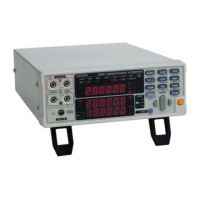Operating Precautions
8
• To ensure certified measurement accuracy, allow at least 60
minutes warm-up. Within the 30- to 60-minute warm-up period,
please double specified accuracy values. After warm-up, be sure
to execute self-calibration.
❖ 5.8 Self-Calibration (Page 66)
• This instrument internally stores (backs up) all settings (except
measurement values), such as measurement range, comparator
settings and etc., but only when no operation is performed for a
certain time. Therefore, to preserve settings, do not turn the power
off for a short time (about five seconds) after changing a setting.
However, measurement settings made through the RS-232C or
GP-IB interface and measurement settings loaded by LOAD
signals of the external I/O terminal are not memorized.
• The direct current that this instrument uses for measuring is
affected by thermoelectromotive force, which can cause
measurement aberrations. In such cases, use the Offset Voltage
Compensation function.
❖ 5.7 Offset Voltage Compensation (OVC) (Page 65)
❖ Appendix 4 Effect of Thermoelectromotive Force (Page 173)
• When measuring objects with a large inductance (L-content) such
as power transformers, the measured value may be unstable. In
such cases, contact your dealer or Hioki representative.
Using the Temperature Probe
• Holding the temperature probe in a bare hand can cause enough
noise pickup to destabilize measurements.
• Temperature Correction does not work if the temperature probe is
allowed to touch the test object. Only the ambient temperature of
the immediate locale should be used.
• Before measuring, install the temperature probe and allow at least
60 minutes warm-up before measurement. Unless the test object
and temperature probe used for temperature correction
measurement have been allowed to completely stabilize at
ambient temperature, large measurement errors may occur.
• Unless the temperature probe is inserted all the way into the TC
SENSOR jack on the rear panel of the instrument, large
measurement errors may occur.

